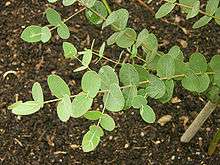Eucalyptus gunnii
| Eucalyptus gunnii | |
|---|---|
 | |
| Foliage and flowers | |
| Scientific classification | |
| Kingdom: | Plantae |
| (unranked): | Angiosperms |
| (unranked): | Eudicots |
| (unranked): | Rosids |
| Order: | Myrtales |
| Family: | Myrtaceae |
| Genus: | Eucalyptus |
| Species: | E. gunnii |
| Binomial name | |
| Eucalyptus gunnii Hook.f. | |
| Subspecies | |
|
E. gunnii subsp. archeri | |
| | |
| Distribution | |
Eucalyptus gunnii, the cider gum[1][2] or gunnii, is a species of flowering plant in the family Myrtaceae, endemic to Tasmania, occurring on the plains and slopes of the central plateaux[3] to around 1100 metres, with isolated occurrences south of Hobart.[4]
Description
It is a small to medium sized evergreen tree. Older specimens have a short, massive bole and large, spreading branches. The bark is often persistent for several metres as a thin, grey stocking, or shedding all over to leave a smooth, yellowish, patchy surface, weathering to white-, green- or pink-grey.
Leaves are stalked, elliptical to ovate, to 8 cm long and 3 cm broad, concolorous, grey-green and thick. The foliage will change as the tree matures from a round leaf of waxy blue colour to a more elongated rich green foliage in the older tree but if maintained as a shrub the juvenile foliage will be retained.
White flowers are produced in midsummer.[4]
Cultivation and uses
See also Tasmanian Aborigines - Oyster Bay Tribe

This species is noted for exceptional cold tolerance for a eucalyptus (to −14 °C, exceptionally −20 °C for brief periods) and is now commonly planted as an ornamental tree across the British Isles and some parts of western Europe.[5] Fast-growing, it will produce a tree up to 37 m (121 ft) tall when mature,[6] with growth rates of up to 1.5 m (4 ft 11 in) (rarely 2 m (6 ft 7 in)) per year. Pruning can be employed to maintain the tree as a small shrub if required and more shaded spots will restrict growth. It does grow on sandy/chalky soils, but prefers a loamy soil; it does not tolerate very wet sites.
This plant has gained the Royal Horticultural Society's Award of Garden Merit.[7]
The plant produces a sweet sap similar to maple syrup, and is being considered for cultivation for this product. When bottled and capped, the liquid ferments and resembles apple cider, hence cider gum. The sweet foliage is eagerly eaten by livestock.
References
- ↑ "Eucalyptus gunnii". Natural Resources Conservation Service PLANTS Database. USDA. Retrieved 19 January 2016.
- ↑ "BSBI List 2007". Botanical Society of Britain and Ireland. Archived from the original (xls) on 2015-02-25. Retrieved 2014-10-17.
- ↑ Kirkpatrick, J. B. & Backhouse, Sue. (2004), Native trees of Tasmania illustrations Sue Backhouse Pandani Press, Sandy Bay, Tas. (Seventh Edition) ISBN 0-646-43088-2. pp. 98 at high altitude on dolerite mountains
- 1 2 Brooker, K. (1996). Eucalyptus. An illustrated guide to identification. Reed Books, Melbourne
- ↑ Brooker, M. (1983). A Key to Eucalypts in Britain and Ireland. Forestry Commission Booklet 50.
- ↑ Tree Register of the British Isles
- ↑ "Eucalyptus gunnii AGM". Royal Horticultural Society. Retrieved 26 July 2013.
| Wikimedia Commons has media related to Eucalyptus gunnii. |